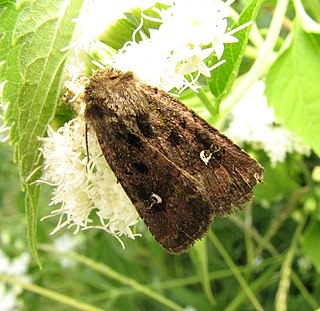
Lacinipolia is a moth genus in the family Noctuidae.
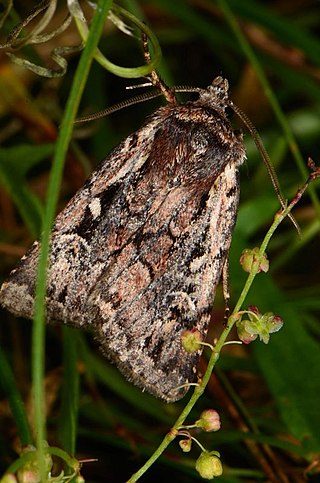
Xestia agathina, the heath rustic, is a moth of the family Noctuidae. It is found in western and central Europe and Morocco.

Aseptis ethnica is a moth of the family Noctuidae first described by John Bernhardt Smith in 1899. It is found in North America in Arizona, California, western Oregon, and Baja California Norte in Mexico. The habitat consists of open pine and oak forest and mountain chaparral, mostly at elevations of above 1500 meters in southern California but at lower elevations farther north.

The Erebidae are a family of moths in the superfamily Noctuoidea. The family is among the largest families of moths by species count and contains a wide variety of well-known macromoth groups. The family includes the underwings (Catocala); litter moths (Herminiinae); tiger, lichen, and wasp moths (Arctiinae); tussock moths (Lymantriinae), including the arctic woolly bear moth ; piercing moths ; micronoctuoid moths (Micronoctuini); snout moths (Hypeninae); and zales, though many of these common names can also refer to moths outside the Erebidae. Some of the erebid moths are called owlets.

Chloantha hyperici, the pale-shouldered cloud, is a moth of the family Noctuidae. It is found in southern Central Europe and from southern Europe to the Near East and Anatolia, Israel, Iraq, the Persian Gulf and the Caucasus, as well as northern Denmark, southern Sweden, southern Norway and south-western Finland.

Ufeus hulstii is a moth in the family Noctuidae. It is widely distributed in western North America, from central Alaska southward to south-central Mexico and from the Rocky Mountain foothills to the West Coast.

Ufeus faunus is a moth in the family Noctuidae. It is found in the south-western United States, from south-western California to southern New Mexico.
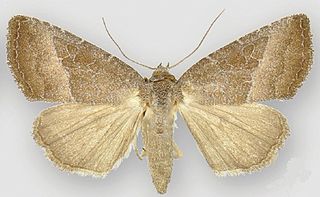
Ogdoconta cinereola, the common pinkband moth, is a moth in the family Noctuidae. It is found in eastern, central, and south-western North America. It occurs from southern Ontario and Quebec south to southern Florida. At the western edge of its distribution, it occurs from Manitoba southward through the Great Plains of Nebraska and Iowa, south throughout most of Texas, and westward through southern New Mexico to south-eastern Arizona. The distribution extends south to the state of Coahuila in northern Mexico.

Hydraecia medialis is a moth in the family Noctuidae. It is found in western North America. East of the Cascades, it occurs as far north as the Cariboo region in south-central British Columbia. The range extends across the Rocky Mountains in Montana and then spreads north and south on the Great Plains to reach Alberta, the western Dakotas and northern New Mexico. The habitat consists of open ponderosa pine forests, drier sagebrush steppe and juniper woodlands.

Fishia yosemitae, the dark grey fishia or grey fishia, is a moth in the family Noctuidae. It is found from central Alberta to Colorado in the Rocky Mountain and Great Plains regions. It is also found in eastern, central, and southern California, as well as in the Intermountain region. The habitat consists of dry open areas, including open ponderosa pine forests, juniper woodlands and sagebrush steppe at low to middle elevations.
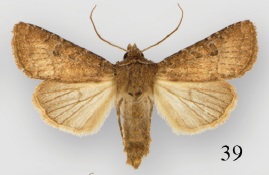
Protorthodes ustulata is a moth in the family Noctuidae first described by J. Donald Lafontaine, J. Bruce Walsh and Clifford D. Ferris in 2014. It is found in North America from south-eastern Wyoming southward to the Guadalupe Mountains in western Texas and westward to central and south-eastern Arizona and northern Mexico.

Protorthodes perforata is a moth in the family Noctuidae first described by Augustus Radcliffe Grote in 1883. It is found across the southern United States, from western Texas to southern California and southward to central Mexico.

Protorthodes alfkenii is a moth in the family Noctuidae first described by Augustus Radcliffe Grote in 1895. It is found in North America from central Oregon, southern Idaho, central Wyoming and north-western Texas southward to southern Mexico. The habitat consists of open arid woodlands.

Panchrysia aurea is a moth of the family Noctuidae. It is found in southern Europe and western and central Asia. The range extends from Portugal, east to Tian Shan, the Altai and the north-western Himalayas. In central Europe, it is found in the southern Alps, lower Austria and the mountains on the Balkan Peninsula.

Lacinipolia vicina is a moth in the family Noctuidae. It is found in Massachusetts, New York, Pennsylvania, Virginia, North Carolina, New Jersey and possibly Indiana.
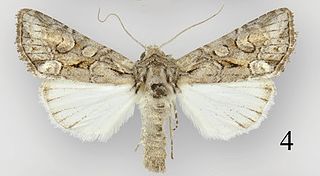
Lacinipolia teligera is a moth in the family Noctuidae. It is found from the Great Plains of central Colorado and eastern Kansas southward to central Texas.

Lacinipolia acutipennis is a moth in the family Noctuidae. It is common throughout xeric, low elevation habitats of western North America. The core range includes the dry, western portions of the Great Plains, the Great Basin, and the western intermontane valleys north of the Sonoran zone, from southern Saskatchewan and Alberta southward to northern Arizona and New Mexico.

Lacinipolia sareta is a moth in the family Noctuidae. It is found throughout western North America, from the southern Yukon and the Northwest Territories to Texas, Arizona and California. It probably also occurs in northern Mexico. It ranges eastward across the southern boreal region to at least Quebec.

Lacinipolia dimocki is a moth in the family Noctuidae. It is found on the eastern slope of the Washington Coast Ranges to southern California.
Lacinipolia incurva is a species of moth in the family Noctuidae. It was described by John B. Smith in 1888 and is found in North America, where it has been recorded from California, Arizona, New Mexico, Texas, Utah and Colorado.




















